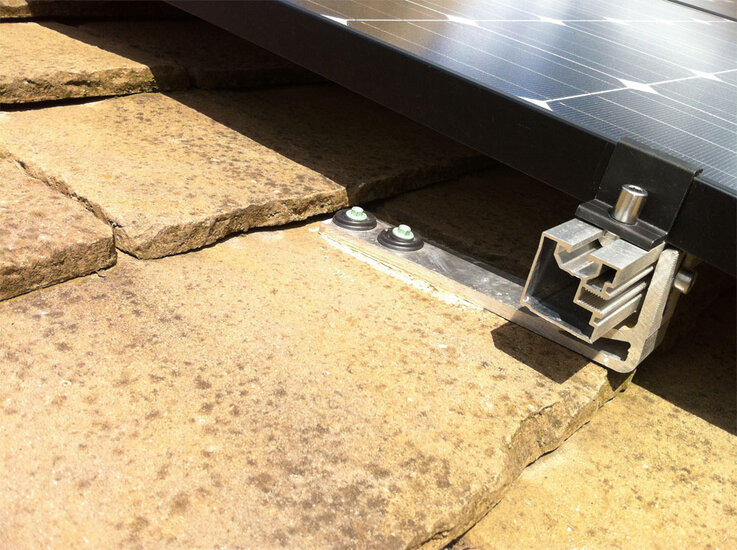I
IronLiver
Hi All
I went to inspect an installation yesterday at a customer's request as the company has now ceased trading. The installation was quite neat in general, though I'm not quite sure what to say about the method used to mount the brackets.
I have attached a picture below showing what I found.

The installer has drilled the tiles and used a fixing with a rubber seal as well as applying mastic or similar sealant to the underside of the anchor and presumably into the holes to maintain water tightness. I am not overly convinced by this method of acheiving an effective seal (consequently we have never used hanger bolt style fixings on slate roofs) and I am also wondering what damage may occur over time to the tiles.
That said and to be quite honest given the size of the tiles I am not sure what we would have done in this instance either. I think we would at least have flashed over the top of the bracket and tried to devise some way of fixing directly to the rafter, but just how you would go about doing this is a bit of a mystery. If you remove the tile completely to accomodate the bracket and then flash this could leave unsightly gaps. Cutting the tiles would risk damaging them but might be the best option. The tile does look like it could withstand a fair amount of abuse. Has anyone got any comments regarding the fixing method employed or indeed any suggestions for a better way of doing it?
I don't want to include this in my report without being able to offer some kind of solution. The wording of the MCS standard is pretty clear on this subject and I am not sure that the grommets used are "durable solutions", though I know this is debatable; according to MIS 3002:-
4.4.2 All roof penetrations (e.g. for PV modules, cables or bracketry) must be durably
sealed using purpose-made products capable of accommodating the movement
and temperatures to which they may be subjected.
Note: In all circumstances the building's weather tightness must be maintained. Holes drilled
through roofing felt and/or roof tiles/slates sealed with mastic or silicone sealant are not
considered durable. Purpose-made roof tiles and flashings for the routing of cables from a PV
module are examples of durable solutions.
Any help you can offer would be appreciated.
Cheers
Monty
I went to inspect an installation yesterday at a customer's request as the company has now ceased trading. The installation was quite neat in general, though I'm not quite sure what to say about the method used to mount the brackets.
I have attached a picture below showing what I found.

The installer has drilled the tiles and used a fixing with a rubber seal as well as applying mastic or similar sealant to the underside of the anchor and presumably into the holes to maintain water tightness. I am not overly convinced by this method of acheiving an effective seal (consequently we have never used hanger bolt style fixings on slate roofs) and I am also wondering what damage may occur over time to the tiles.
That said and to be quite honest given the size of the tiles I am not sure what we would have done in this instance either. I think we would at least have flashed over the top of the bracket and tried to devise some way of fixing directly to the rafter, but just how you would go about doing this is a bit of a mystery. If you remove the tile completely to accomodate the bracket and then flash this could leave unsightly gaps. Cutting the tiles would risk damaging them but might be the best option. The tile does look like it could withstand a fair amount of abuse. Has anyone got any comments regarding the fixing method employed or indeed any suggestions for a better way of doing it?
I don't want to include this in my report without being able to offer some kind of solution. The wording of the MCS standard is pretty clear on this subject and I am not sure that the grommets used are "durable solutions", though I know this is debatable; according to MIS 3002:-
4.4.2 All roof penetrations (e.g. for PV modules, cables or bracketry) must be durably
sealed using purpose-made products capable of accommodating the movement
and temperatures to which they may be subjected.
Note: In all circumstances the building's weather tightness must be maintained. Holes drilled
through roofing felt and/or roof tiles/slates sealed with mastic or silicone sealant are not
considered durable. Purpose-made roof tiles and flashings for the routing of cables from a PV
module are examples of durable solutions.
Any help you can offer would be appreciated.
Cheers
Monty








